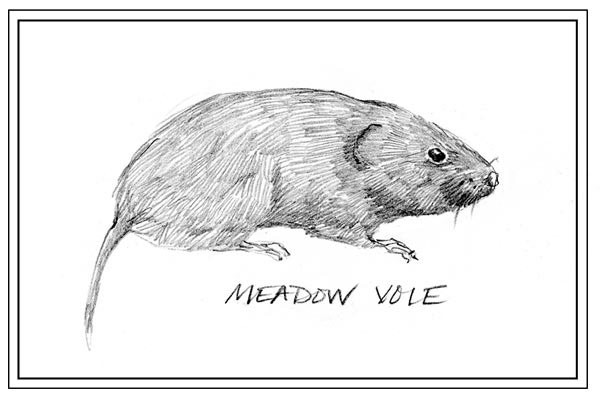
In years when the snow is deep, voles, the most abundant mammal in the Northeast, thrive. When the snow recedes, the glaring white of rodent-chewed bark shows up on saplings along field edges, roadsides, and, especially, in orchards.
In addition to bark, meadow voles will eat almost every agricultural crop. When, as sometimes happens, there are thousands of these metabolically active animals per acre, the damage can be significant, even though each one weighs just an ounce or two.
The population fluctuations of meadow voles (sometimes called meadow mice) have interested and puzzled biologists for centuries. As with their close relatives, the lemmings, meadow vole population size varies dramatically, often on a four-year schedule. Once in a while it shoots sky-high, only to collapse precipitously. Such over-exploitation of resources, followed by massive die-offs, might seem the very definition of disaster, but biologists speculate that the species as a whole may benefit from this pattern: only the fittest survive and the animals are periodically forced to explore new habitats.
Meadow voles have a greater capacity for population increase than any other North American mammal. Open almost any book about mammals, turn to the vole section, and you will read that in a single year a captive meadow vole produced 17 litters, averaging five babies each time, for a total of 83 offspring. If the vole in this much-cited 1941 report had the usual 21-day pregnancy, she was not-pregnant for only eight days that year. (Meadow voles can breed year round if there is an insulating blanket of snow.) Females are reproductively mature at about one-month old, so think of the reproductive potential if that vole had produced the maximum litter size of nine babies each time – and not wasted those eight days. Lots of people have thought of that and have arrived at numbers exceeding a million voles in one year from just one vole mother. For the whole Northeast, vole-to-vole carpeting, as a friend of mine has called it, wouldn’t take very long.
Fortunately, this exercise tells us more about the horrors of exponential growth than it does about meadow voles. These dark brown, furry little creatures are 3-1/2 to 5 inches long, plus a short tail, and spend their usually short lives converting vegetable matter to protein-rich wildlife food. They are staples in the diet of hawks, owls, ravens, herons, weasels, coyotes, fisher, fox, bobcat, many snakes, and big frogs – those that enter water may even get eaten by fish. The average life span for a meadow vole is about a month.
Meadow voles are predominantly creatures of open land, for grasses are their preferred food in summer. Orchards are ideal, providing grass in summer and fruit tree bark in winter. Apple growers protect young trees with wire mesh or plastic wraps or poison voles with bait – or both. In the eastern forest, voles frequently girdle black cherry, black locust, all the oaks, chestnut, and hickory saplings, especially if they are in or near openings. However, the economic cost of meadow vole debarking is minimal except in nurseries or orchards.
There is a common forest-dwelling vole in our region, the southern red-backed vole. This smaller rodent has gray sides and a reddish stripe down the back. It tunnels among mosses and rotting logs in moist coniferous or mixed-wood forests, searching out insects throughout the year and eating plant matter in season: green shoots and leaf petioles in spring; berries, fruit, and fungi in summer; seeds and nuts in fall; and more seeds, tree roots, and deciduous tree bark in the winter. Its population fluctuations are much less dramatic, and it rarely is considered a pest. As with all small mammals, it is more abundant in late summer and early fall. Cold and predators take their toll in the winter.
The smallest and reddest of the common voles is the least often seen. The pine vole (Microtus pinetorum) has small eyes and inconspicuous ears. Perhaps because it is so small and loses heat so easily, it usually stays underground, where temperatures are moderated. The pine vole can be found in forests, grasslands, marshes, or swamps. It can also be found in orchards where it has earned a bad reputation among orchardists because its subterranean gnawing on tree roots is very hard to control.

